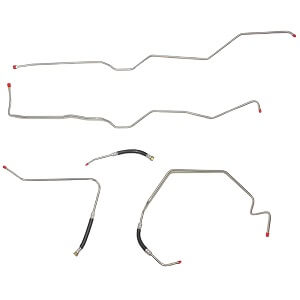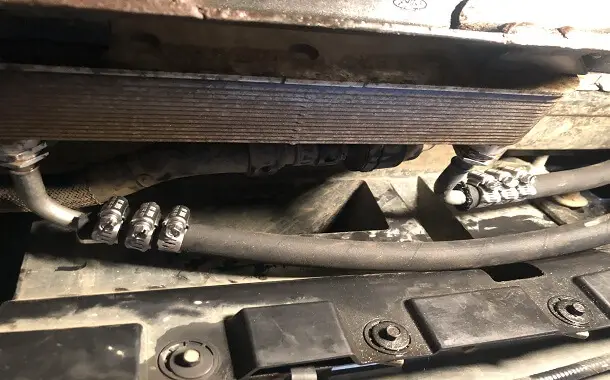How Much Does Transmission Cooling Line Replacement Cost?
The transmission cooler lines are an essential part of a well-functioning of the engine. The engine when running, works in high temperatures, and all the car’s fluids especially the transmission’s fluid can overheat causing functioning problems.
To prevent this from happening, transmission cooler lines will recirculate the transmission fluid to the car’s radiator and back to the transmission system, to remove the excessive heat.
Like any other car part, the transmission cooler lines can also be damaged, causing different problems to the engine.
How Much Does Transmission Cooling Line Replacement Cost?
The average cost for replacing the transmission cooling lines is around $350 per part and labor. Depending on the make and model of the car, the costs can get anywhere from $100 to $500. However, for high-end cars, the cost of repairing the cooling lines may exceed $500.
Generally, the average cost range for the parts will be somewhere from $40 to $160. As for the labor, the costs can be anywhere between $60 and $350. These costs may vary depending on the make and model of your car, the place where you purchase the parts, your geographical location, and the mechanic that you hire for the job.
The table below lists different shops from where you can purchase transmission cooler line parts and their costs:
| Auto Center | Costs |
|---|---|
| Amazon | $9 to $174 |
| Midas | $57 to $204 |
| Mr. Tire | $120 to $310 |
| Napa | $61 to $214 |
| Walmart | $15 to $194 |
| Your Mechanic | $55 to $192 |
AutoGuru.com says that the cost of replacing the transmission cooler lines can be anywhere from $100 up to $450, depending on the make and model of your car.
On the dedicated website MyTransmissionExperts.com, you’ll find that the cost range for this job can be from $100 to $500, and the replacement itself is a relatively simple fix.
Another example is CarColony.com, which states that for the parts you can expect to pay between $40 and $160. The same website points out that the labor cost can be anywhere from $60 to $300.
To give you an idea about the costs of repairing the transmission cooler lines, we compiled the table below with different car makes and models and their average costs:
| CAR’S MAKE AND MODEL | AVERAGE COST |
|---|---|
| Kia Sorento 2006 | $135 |
| Mazda CX-9 2011 | $287 |
| Mercedes-Benz SL55-AMG 2007 | $421 |
| Mini Cooper Countryman 2011 | $132 |
| Chevrolet Cruze 2013 | $180 |
| Cadillac DTS 2008 | $200 |
| Chevrolet Colorado 2010 | $950 |
| Ford Mustang 2015 | $841 |
| Ford F-150 2011 | $600 |
| Dodge Grand Caravan 2014 | $514 |
According to CarAdvise.com, the cost range for the transmission cooler line repair or replacement can be anywhere from $198 up to $446, with an average cost of $305.
SpendAuto.com claimed that for a 2005 Honda Odyssey, the cost of repairing the transmission cooler lines is around $320 for 2.8 hours of work time, while for a 2011 Nissan Xterra with a 4.0-liter engine with 1.4 hours of labor time, the cost is $250.
You might also like our articles about the cost of ECM replacement, coolant hose replacement, or car thermostat replacement.
AutoZone has a listing of different transmission cooler lines with costs that can go as little as $15 to as much as $280.
Based on several mechanics’ quotes from the RepairPal.com thread, the cost range for this job is between $100 and $446.
One member of the GMInsideNews.com forum stated that he paid $624 at a local dealer to replace the cooling line on his Silverado Classic 1500 Crew Cab. He also stated that the cost of the parts was only $90 and the other $534 was for the labor.
Transmission Cooler Lines Overview
The transmission cooler lines have an essential role in the transmission fluid cooling process. Due to the high temperature of the engine when running, the engine’s fluids will also overheat. To prevent this from happening, the transmission cooling lines will constantly circulate the transmission fluid (ATF) to the radiator to be cooled and back to the transmission system, as many times as it is necessary.
The cooling lines are two tubes one through which the heated transmission fluid will pass to the coolant radiator and the second one to transfer the cooled fluid from the radiator back to the transmission system.
The transmission cooler lines are usually manufactured from different materials such as rubber, metal, braided steel, and braided nylon.
Symptoms of a poor transmission cooling line or a leak
There are several symptoms when the transmission cooling line may be faulty, such as:
- Transmission fluid leaks – Even though leaking is very common in a car, finding some red stains of liquid under your car, is a sign that your transmission cooling lines may be damaged and need to be replaced.
- Low fluid levels – If there are any suspicions that there may be ATF leaks, checking your fluid levels and noticing low or nonexistent fluids, will confirm your worries.
- Lines with visible damage – Inspect the cooling lines to see if there are any lumps, cracks, and holes. If you find any of these, you will have to replace the lines.
- Noises – Losing fluid, the transmission will not be lubricated properly. If that is the case, you may hear grinding noises when shifting, or most commonly when you shift to park after driving.
- Poor shifting response – Having trouble shifting from one gear to another, may be a sign of low fluid level, usually caused by leaking transmission cooling lines.
- Burning smell – A low level of ATF will overheat the transmission system generating a burning smell.
Repairing the transmission cooling line
A low level of fluids may be due to several different causes, which is why it is best to consult a mechanic, before repairing the transmission cooling lines.
The mechanic will first inspect all the transmission systems to see if the cooling lines are leaking or not. If the issue is confirmed and the transmission cooling line repair is a must, the mechanic will first drain the transmission cooler and unplug the cooling lines.
Once the mechanic ensures that the old and new transmission cooling lines are the same size, the new lines will be installed and plugged into the radiator and then into the transmission.
The last step is to refill the fluid and verify if there are no other leaks.
Tips to know
 Generally, the average time for the entire process is around 1.5 hours.
Generally, the average time for the entire process is around 1.5 hours.
Damaged transmission cooling lines cannot be repaired and need to be replaced with a new assembly.
There is no lifespan for a cooling line because there is a constant heating and cooling process that will harden the material which may cause it to crack.
The material quality of the trans-cooling lines will have a great impact on their lifespan.
Also, keep in mind that your driving style can often affect the system. If you drive more aggressively and the engine’s RPMs are high, the engine will overheat, a factor that will require the process of fluid cooling more often. In this case, the cooling lines can be overused, making them fail sooner.
Check your fluid level regularly. Your level may be low even though there are no visible leaks.
How can I save money?
In order to save money that will go towards labor if hiring a mechanic, you can do the job yourself. If you have basic mechanic knowledge and the proper tools, acquire the transmission cooling lines and replace them yourself.
Usually, mechanics will give you a free diagnosis if you intend to hire them for the job.
Some mechanics will allow you to buy the part yourself. This way you can compare prices and find the best deal.



Leave a Reply
Want to join the discussion?Feel free to contribute!